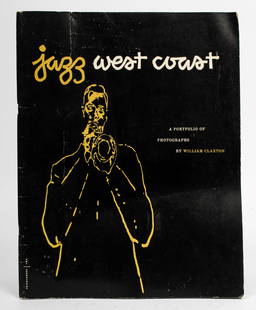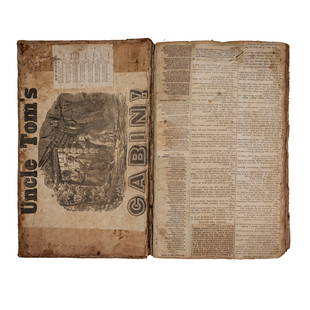
Successful Nighttime Destruction of a Grounded
Similar Sale History
View More Items in Books
Related Books

More Items in Books
View MoreRecommended Books, Magazines & Papers
View More



Item Details
Description
Naval History “I returned to my ship, and called for a boats crew of volunteers to accompany a boat from your ship for the purpose of firing the blockade runner on shore.”
This letter details the nighttime expedition by two boats from ships of the Union blockade to destroy a blockade runner that had run aground on Galveston Island. The Union sailors successfully set fire to the Wil-o’-the-wisp to prevent the Confederates from using it for further blockade running out of Galveston, Texas.
JOHN F. HARDEN, Autograph Letter Signed, to Melancthon B. Woolsey, February 10, 1865, USS Antona off Galveston, Texas. 4 pp., 5" x 7.875". Expected folds, very good.
Excerpt “In obedience to orders received from you last evening, I have the honor to report that I returned to my ship, and called for a boats crew of volunteers to accompany a boat from your ship for the purpose of firing the blockade runner on shore. Acting Ensign William G. Jones (who previously asked me for a boats crew for the same purpose) Acting Asst Paymaster H. M. Whittman and twelve Petty officers and men immediately responded, and after making the necessary preparation, I gave Mr Jones order to report with the boats crew under his charge to you and to obey your instructions. when the boats left your ship I got underway and took the position you had assigned for the ‘Antona’ for the purpose of covering the expedition in thirteen feet of water to the Eastward of the wreck ready to open fire when your ship should do so. No demonstration was made on the boats, which returned after accomplishing the object of the expedition....”
Historical Background Despite Union efforts to blockade it, the port of Galveston, Texas, remained open in late 1862. On October 4, the commander of the USRC Harriet Lane sailed into the harbor under a flag of truce and demanded the town’s surrender. After the local Confederate commander ignored the message, four Union steamers and a mortar boat entered the harbor and disabled the one Confederate cannon protecting the town. The Confederates evacuated the town, and the Union forces closed the port.
However, on January 1, 1863, Confederate forces under General John B. Magruder successfully expelled the Union forces from Galveston and reopened the port. In a daring maneuver, two Confederate cottonclads, steamships protected by bales of cotton lining their sides, attacked the larger and better armed Union fleet. Although one of the cottonclads was quickly disabled and eventually sank, the other captured the USS Harriet Lane. In the action, the USS Westfield grounded on a sandbar. The Union commander blew up the Westfield to prevent its falling into Confederate hands. Union troops on shore, believing their fleet defeated, surrendered to Confederate troops. The other Union ships retreated to New Orleans, and despite future efforts by the Union navy, the port of Galveston remained in Confederate hands through the end of the war.
The Will-o’-the-Wisp was constructed on the River Clyde in Scotland by Simons & Co., of the London Works. She first left the river in November 1863 specifically to run the Union blockade of the Confederacy. The ship made several successful runs into and out of Wilmington, North Carolina, before running aground off Galveston early in February 1865.
The report by Acting Ensign William G. Jones that originally accompanied this letter gave further details of the operation. He and fourteen volunteers, “well armed, and equipped with the necessary materials” reported to the USS Princess Royal. There, they met another boat with volunteers commanded by Lieutenant Charles E. McKay and at 3:00 a.m. rowed toward the wreck of the Will-o’-the-Wisp. They boarded the grounded blockade runner at 3:40 a.m. and immediately set it afire with forty pounds of oakum (untwisted old rope), saturated with three gallons of turpentine. The expedition then returned to the Princess Royal, at which they arrived by 4:15 a.m., and Jones’s boat returned to the Antona at 4:30 a.m. They saw only one Confederate, a picket on the beach, “who fled on our approach.”
John F. Harden (1829-1877) was born in Maine into a seafaring family. He married Sarah in 1851, and they had at least three sons. In 1862, he was an acting master aboard the steam-sloop USS Iriquois. In 1863, Harden was master of the bark USS Kuhn off New Orleans. He also commanded the USS Tonawanda. Later, he was placed in command as an Acting Volunteer Lieutenant of the fourth-rate steamer USS Antona as part of the West Gulf Squadron. Before and after the war, he was a shipmaster, primarily engaged in the coasting trade.
Melancthon Brooks Woolsey (1817-1874) was born in New York as the son of a U.S. Navy captain. The younger Woolsey began his naval service as a midshipman in 1832 and rose to the rank of lieutenant by 1847. Placed on the reserve list in 1855, he was recalled to active service at the beginning of the Civil War. From late 1861 to mid-1862, he commanded the USS Ellen off the Atlantic coast from South Carolina to Florida. In mid-1862, he took command of the sloop of war USS Vandalia and in early 1863 became the commanding officer of the USS Princess Royal, on which he served in the Gulf of Mexico until the end of the war. After the war, he commanded the USS Pawnee and later the USS Guerriere in the south Atlantic. Promoted to Commodore in 1871, he was placed in charge of the South Atlantic station and then the Pensacola Navy Yard, where he died of yellow fever.
WE PROVIDE IN-HOUSE SHIPPING WORLDWIDE
Ex: William Burger Collection.
This letter details the nighttime expedition by two boats from ships of the Union blockade to destroy a blockade runner that had run aground on Galveston Island. The Union sailors successfully set fire to the Wil-o’-the-wisp to prevent the Confederates from using it for further blockade running out of Galveston, Texas.
JOHN F. HARDEN, Autograph Letter Signed, to Melancthon B. Woolsey, February 10, 1865, USS Antona off Galveston, Texas. 4 pp., 5" x 7.875". Expected folds, very good.
Excerpt “In obedience to orders received from you last evening, I have the honor to report that I returned to my ship, and called for a boats crew of volunteers to accompany a boat from your ship for the purpose of firing the blockade runner on shore. Acting Ensign William G. Jones (who previously asked me for a boats crew for the same purpose) Acting Asst Paymaster H. M. Whittman and twelve Petty officers and men immediately responded, and after making the necessary preparation, I gave Mr Jones order to report with the boats crew under his charge to you and to obey your instructions. when the boats left your ship I got underway and took the position you had assigned for the ‘Antona’ for the purpose of covering the expedition in thirteen feet of water to the Eastward of the wreck ready to open fire when your ship should do so. No demonstration was made on the boats, which returned after accomplishing the object of the expedition....”
Historical Background Despite Union efforts to blockade it, the port of Galveston, Texas, remained open in late 1862. On October 4, the commander of the USRC Harriet Lane sailed into the harbor under a flag of truce and demanded the town’s surrender. After the local Confederate commander ignored the message, four Union steamers and a mortar boat entered the harbor and disabled the one Confederate cannon protecting the town. The Confederates evacuated the town, and the Union forces closed the port.
However, on January 1, 1863, Confederate forces under General John B. Magruder successfully expelled the Union forces from Galveston and reopened the port. In a daring maneuver, two Confederate cottonclads, steamships protected by bales of cotton lining their sides, attacked the larger and better armed Union fleet. Although one of the cottonclads was quickly disabled and eventually sank, the other captured the USS Harriet Lane. In the action, the USS Westfield grounded on a sandbar. The Union commander blew up the Westfield to prevent its falling into Confederate hands. Union troops on shore, believing their fleet defeated, surrendered to Confederate troops. The other Union ships retreated to New Orleans, and despite future efforts by the Union navy, the port of Galveston remained in Confederate hands through the end of the war.
The Will-o’-the-Wisp was constructed on the River Clyde in Scotland by Simons & Co., of the London Works. She first left the river in November 1863 specifically to run the Union blockade of the Confederacy. The ship made several successful runs into and out of Wilmington, North Carolina, before running aground off Galveston early in February 1865.
The report by Acting Ensign William G. Jones that originally accompanied this letter gave further details of the operation. He and fourteen volunteers, “well armed, and equipped with the necessary materials” reported to the USS Princess Royal. There, they met another boat with volunteers commanded by Lieutenant Charles E. McKay and at 3:00 a.m. rowed toward the wreck of the Will-o’-the-Wisp. They boarded the grounded blockade runner at 3:40 a.m. and immediately set it afire with forty pounds of oakum (untwisted old rope), saturated with three gallons of turpentine. The expedition then returned to the Princess Royal, at which they arrived by 4:15 a.m., and Jones’s boat returned to the Antona at 4:30 a.m. They saw only one Confederate, a picket on the beach, “who fled on our approach.”
John F. Harden (1829-1877) was born in Maine into a seafaring family. He married Sarah in 1851, and they had at least three sons. In 1862, he was an acting master aboard the steam-sloop USS Iriquois. In 1863, Harden was master of the bark USS Kuhn off New Orleans. He also commanded the USS Tonawanda. Later, he was placed in command as an Acting Volunteer Lieutenant of the fourth-rate steamer USS Antona as part of the West Gulf Squadron. Before and after the war, he was a shipmaster, primarily engaged in the coasting trade.
Melancthon Brooks Woolsey (1817-1874) was born in New York as the son of a U.S. Navy captain. The younger Woolsey began his naval service as a midshipman in 1832 and rose to the rank of lieutenant by 1847. Placed on the reserve list in 1855, he was recalled to active service at the beginning of the Civil War. From late 1861 to mid-1862, he commanded the USS Ellen off the Atlantic coast from South Carolina to Florida. In mid-1862, he took command of the sloop of war USS Vandalia and in early 1863 became the commanding officer of the USS Princess Royal, on which he served in the Gulf of Mexico until the end of the war. After the war, he commanded the USS Pawnee and later the USS Guerriere in the south Atlantic. Promoted to Commodore in 1871, he was placed in charge of the South Atlantic station and then the Pensacola Navy Yard, where he died of yellow fever.
WE PROVIDE IN-HOUSE SHIPPING WORLDWIDE
Ex: William Burger Collection.
Buyer's Premium
- 25%
Successful Nighttime Destruction of a Grounded
Estimate $600 - $700
1 bidder is watching this item.
Shipping & Pickup Options
Item located in Westport, CT, usSee Policy for Shipping
Payment

Related Searches
TOP










































![19 issues of rare Gay Magazine METRA 1985-1986: [Queer interest], Metra: Midwest America's Leading Free Gay Magazine, 19 issues, published 1986-1987, a few duplicates, softcover, staplebound wraps, illustrated throughout in black and white, publish](https://p1.liveauctioneers.com/184/328649/177016396_1_x.jpg?height=310&quality=70&version=1714770323)
























